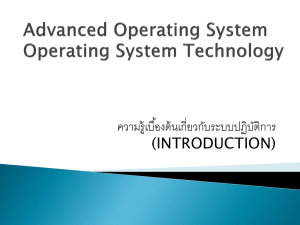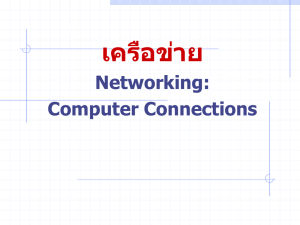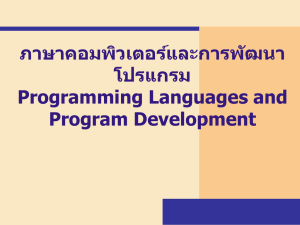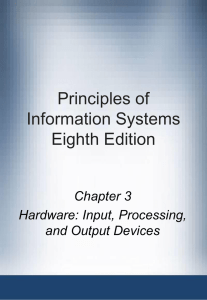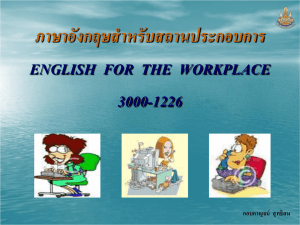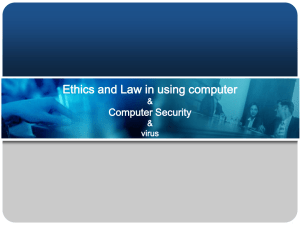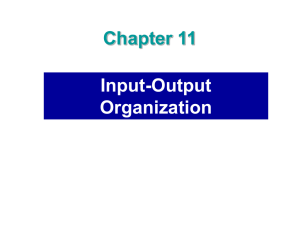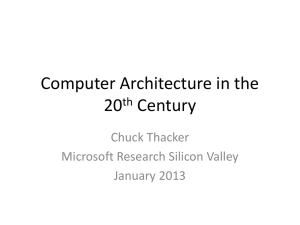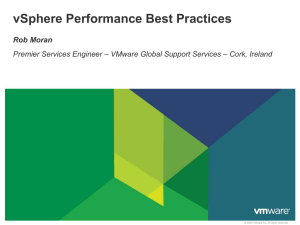Management Information Systems 8/e Managing Hardware and
advertisement
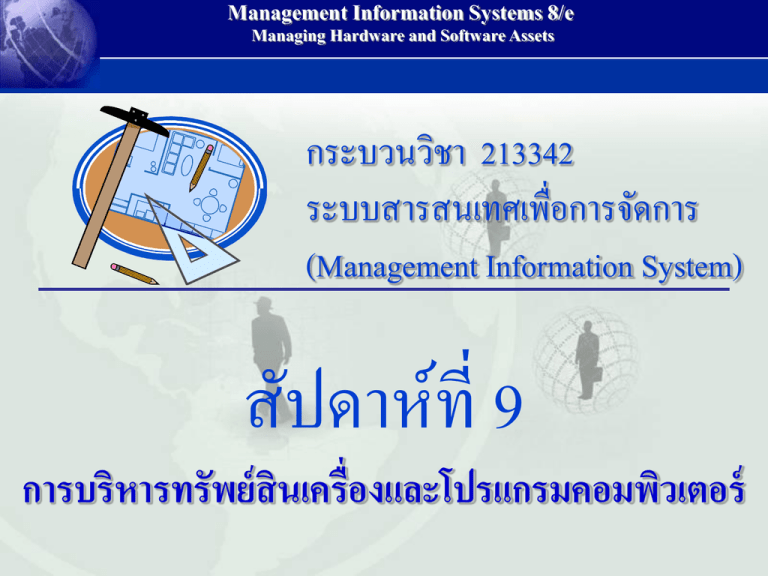
Management Information Systems 8/e Managing Hardware and Software Assets กระบวนวิชา 213342 ระบบสารสนเทศเพื่อการจัดการ (Management Information System) สัปดาห์ที่ 9 การบริหารทรัพย์ สินเครื่องและโปรแกรมคอมพิวเตอร์ Management Information Systems 8/e Managing Hardware and Software Assets วัตถุประสงค์ คอมพิวเตอร์ ที่ความสามารถ (ในการประมวลผลและเก็บข้ อมูล) ระดับใดที่ องค์ กรของเราต้ องการใช้ งาน เพือ่ จัดการสารสนเทศและ ธุรกรรมทางธุรกิจ? จะจัดเตรียมคอมพิวเตอร์ และการประมวลผลแบบใดทีจ่ ะสร้ างประโยชน์ สู งสุ ดให้ แก่องค์ กรของเรา? โปรแกรมคอมพิวเตอร์ และเครื่องมืออรรถประโยชน์ ชนิดใดทีเ่ ราต้ องการเพือ่ นามาใช้ ในธุรกิจของเรา เกณฑ์ ใดทีเ่ ราต้ องมีเพือ่ นามาใช้ คดั เลือกเทคโนโลยี ซอฟท์ แวร์ ? Management Information Systems 8/e Managing Hardware and Software Assets OBJECTIVES เทคโนโลยีโปรแกรมคอมพิวเตอร์ ใหม่ ๆ แบบใดทีเ่ ราควรทาความรู้ จัก? เทคโนโลยีโปรแกรมคอมพิวเตอร์ จะสร้ างประโยชน์ ให้ กบั องค์กรของเรา อย่ างไร? เราจะจัดหาให้ ได้ มาและบริหารจัดการทรัพย์ สินเครื่องและโปรแกรม คอมพิวเตอร์ (hardware และ software) ขององค์ กรอย่ างไร? Management Information Systems 8/e Managing Hardware and Software Assets COMPUTER HARDWARE AND INFORMATION TECHNOLOGY INFRASTRUCTURE Hardware Components of a Computer System Figure 6-1 Management Information Systems 8/e Managing Hardware and Software Assets COMPUTER HARDWARE AND INFORMATION TECHNOLOGY INFRASTRUCTURE The Computer System คอมพิวเตอร์ ร้ ู จักข้ อมูลในลักษณะใด Bit • Binary digit • Represents smallest unit of data in the form of either 0 or 1 Byte • • String of bits, usually eight “Byte” Stores one number or character Management Information Systems 8/e Managing Hardware and Software Assets COMPUTER HARDWARE AND INFORMATION TECHNOLOGY INFRASTRUCTURE Bits and Bytes 0 or 1 One bit Characters are represented by one byte for each letter. 0 1 0 0 0 0 0 1 One byte for character A Figure 6-2 Management Information Systems 8/e Managing Hardware and Software Assets COMPUTER HARDWARE AND INFORMATION TECHNOLOGY INFRASTRUCTURE The CPU and Primary Storage Central Processing Unit (CPU) • Manipulates symbols, numbers, and letters มีหน้ าที่ในการจัดการสั ญลักษณ์ ตัวเลข ตัวอักษร • Controls other parts of the computer system ควบคุมการทางานของอุปกรณ์ อนื่ ๆ ทีอ่ ยู่ในเครื่อง Bus สายวงจรทีท่ าหน้ าทีถ่ ่ ายโอนข้ อมูลระหว่ างอุปกรณ์ Management Information Systems 8/e Managing Hardware and Software Assets COMPUTER HARDWARE AND INFORMATION TECHNOLOGY INFRASTRUCTURE The CPU and Primary Storage Primary Storage (Main Memory) • Temporarily stores program instructions เก็บข้อมูลและโปรแกรมหรื อชุดคาสัง่ ไว้ชวั่ คราว สาหรับการประมวลผล Data Bus เส้นทางในการถ่ายเทข้อมูล Address Bus เส้นทางในการบอกตาแหน่งข้อมูล Control Bus เส้นทางส่ งสัญญาณควบคุมการทางานของอุปกรณ์ Management Information Systems 8/e Managing Hardware and Software Assets COMPUTER HARDWARE AND INFORMATION TECHNOLOGY INFRASTRUCTURE The CPU and Primary Storage Figure 6-3 Management Information Systems 8/e Managing Hardware and Software Assets COMPUTER HARDWARE AND INFORMATION TECHNOLOGY INFRASTRUCTURE Primary Storage Stores • Software program being executed เก็บชุดคาสัง่ ชัว่ คราวเพื่อรอการประมวลผล หรื อโปรแกรมที่กาลังทางานอยู่ • Operating system programs เก็บโปรแกรมระบบปฏิบตั ิการในการ บริ หารจัดการเครื่ องคอมพิวเตอร์ • Data being used by program ข้อมูลจะถูกเก็บไว้ในหน่วยความจาหลัก ก่อนการประมวลผล Management Information Systems 8/e Managing Hardware and Software Assets COMPUTER HARDWARE AND INFORMATION TECHNOLOGY INFRASTRUCTURE CPU • Arithmetic-logic unit (ALU): performs the computer’s principal logic and arithmetic operations • Control Unit: coordinates and controls the other parts of the computer system Management Information Systems 8/e Managing Hardware and Software Assets COMPUTER HARDWARE AND INFORMATION TECHNOLOGY INFRASTRUCTURE Primary Storage • RAM: Random Access Memory Directly accesses any randomly chosen location in the same amount of time ใช้บนั ทึกข้อมูลและโปรแกรมในช่วงระยะเวลาสั้นๆ ในขณะที่โปรแกรมกาลังทางาน ใช้ได้เฉพาะตอนที่มี ไฟฟ้ าเท่านั้น ข้อมูลในชิพประเภทจะสูญหายทันทีเมื่อ ไฟฟ้ าดับ • ROM: Read Only Memory Semiconductor memory chips with program instructions, cannot be written to เป็ นชิพที่ทาหน้าที่เก็บข้อมูลไว้ในตัวเองอย่างถาวร ไม่ สามารถเขียนเข้าหรื อลบทิ้งได้ ส่ วนใหญ่ใช้เก็บข้อมูล หรื อโปรแกรมสาหรับการบูธ้ เครื่ อง Management Information Systems 8/e Managing Hardware and Software Assets COMPUTER HARDWARE AND INFORMATION TECHNOLOGY INFRASTRUCTURE Computer Processing Microprocessors • Integrated circuit technology (IC-Technology) • Integrates the computer’s memory, logic, and control on a single chip Processing Power (ปัจจัยที่ระบุความสามารถในการประมวลผล) 1. Word Length ความเร็ วในการอ่านข้อมูล (64 Bit > 32 Bit) 2. Clock Speed ระยะเวลาที่ใช้ในแต่ละวงรอบเครื่ อง (1.5 GHz > 4.47 MHz) 3. Data Bus Width ความกว้างของดาต้าบัส (64 Bit > 32 Bit) Pentium 4 (1.5 GHz) • มีความเร็ว Clock Speed = 1,500 ล้านรอบต่อวินาที • มี Word Length = 32 Bit หรื อ 4 byte ต่อวงรอบเครื่ อง • มี Data Bus Width = 64 Bit Management Information Systems 8/e Managing Hardware and Software Assets COMPUTER HARDWARE AND INFORMATION TECHNOLOGY INFRASTRUCTURE Computer Processing Parallel Processing • Problem broken down into smaller parts • Multiple instructions processed simultaneously with multiple processors Management Information Systems 8/e Managing Hardware and Software Assets COMPUTER HARDWARE AND INFORMATION TECHNOLOGY INFRASTRUCTURE Sequential and Parallel Processing Figure 6-4 Management Information Systems 8/e Managing Hardware and Software Assets COMPUTER HARDWARE AND INFORMATION TECHNOLOGY INFRASTRUCTURE Secondary Storage Technology • Magnetic disk: Floppy disk, Hard disk • Optical disks: CD-ROM, DVDs • Magnetic tape: Inexpensive, older secondarystorage medium • New storage alternatives: Storage Area Networks (SANs) Management Information Systems 8/e Managing Hardware and Software Assets COMPUTER HARDWARE AND INFORMATION TECHNOLOGY INFRASTRUCTURE A Storage Area Network (SAN) Figure 6-5 Management Information Systems 8/e Managing Hardware and Software Assets Management Information Systems 8/e Managing Hardware and Software Assets COMPUTER HARDWARE AND INFORMATION TECHNOLOGY INFRASTRUCTURE Input and Output Devices Management Information Systems 8/e Managing Hardware and Software Assets Management Information Systems 8/e Managing Hardware and Software Assets COMPUTER HARDWARE AND INFORMATION TECHNOLOGY INFRASTRUCTURE Input and Output Devices Management Information Systems 8/e Managing Hardware and Software Assets COMPUTER HARDWARE AND INFORMATION TECHNOLOGY INFRASTRUCTURE Batch and On-Line Input and Processing Batch processing • • Transactions accumulated and stored until processing มีประโยชน์กบั การรวบรวมข้อมูลที่ตอ้ งเก็บไว้ประมวลผลพร้อมๆกัน เช่น ผลงานพนักงาน กาไรสุ ทธิ รายวัน รายเดือน งบการเงินรายเดือน รายปี On-line processing • • Transactions are entered directly into computer and processed immediately เหมาะกับการประมวลผลที่ตอ้ งการทราบผลในทันที เช่น การเบิกเงิน ระบบจองตัว๋ ต่างๆ Management Information Systems 8/e Managing Hardware and Software Assets COMPUTER HARDWARE AND INFORMATION TECHNOLOGY INFRASTRUCTURE A Comparison of Batch and On-line Processing Figure 6-6 Management Information Systems 8/e Managing Hardware and Software Assets COMPUTER HARDWARE AND INFORMATION TECHNOLOGY INFRASTRUCTURE Interactive Multimedia • Integrates two or more types of media into a computerbased application as Text , Graphic , Sound , Voice , Images , Animation • Used in interactive Web pages with graphics, sound, animation, video Games , e-Learning , e-Newspaper , e-Conference • Multi-media website – – Streaming Video MP3 (Motion Picture Experts Group, audio player3) Management Information Systems 8/e Managing Hardware and Software Assets CATEGORIES OF COMPUTERS AND COMPUTER SYSTEMS Classifying Computers • Mainframes: Largest computer, massive memory, rapid processing power • Midrange computers: Less powerful, less expensive, and smaller than a mainframe • Server: Provides software and other resources to computers over a network Management Information Systems 8/e Managing Hardware and Software Assets CATEGORIES OF COMPUTERS AND COMPUTER SYSTEMS Classifying Computers • Minicomputers: Middle-range computer, used in universities, factories, or research laboratories • Server Farm: Large group of servers maintained by a commercial vendor, available for electronic commerce and other activities Management Information Systems 8/e Managing Hardware and Software Assets CATEGORIES OF COMPUTERS AND COMPUTER SYSTEMS Classifying Computers • Personal Computer (PC): Small desktop or portable computer • Workstation: Desktop computer with powerful graphics and mathematical capabilities • Supercomputer: Highly sophisticated and powerful, performs complex computations Management Information Systems 8/e Managing Hardware and Software Assets Management Information Systems 8/e Managing Hardware and Software Assets CATEGORIES OF COMPUTERS AND COMPUTER SYSTEMS Computer Networks and Client/Server Computing • Distributed processing: Distribution of processing work among multiple computers (ระบบการกระจายกันประมวลผล) • Centralized processing: Accomplished by one large central computer (ระบบการประมวลผลทีศ่ ูนย์ กลาง) • Client/server computing: Splits processing between “clients” and “servers” on network (ระบบการประมวลผลแบบมีผ้ ใู ห้ บริการและผู้รับบริการ ซึ่งกาลังเป็ นทีน่ ิยม) Management Information Systems 8/e Managing Hardware and Software Assets CATEGORIES OF COMPUTERS AND COMPUTER SYSTEMS Client/Server Computing Figure 6-7 Management Information Systems 8/e Managing Hardware and Software Assets CATEGORIES OF COMPUTERS AND COMPUTER SYSTEMS Types of Client/Server Computing Figure 6-8 Management Information Systems 8/e Managing Hardware and Software Assets CATEGORIES OF COMPUTERS AND COMPUTER SYSTEMS Network Computers and Peer-to-Peer Computing • Network computer (NC): Simplified desktop computer, does not store data permanently • Peer-to-peer computing: Distributed • processing that links computers through Internet or private networks Grid computing: Applies computational resources of many networked computers to solve a large, complex problem Management Information Systems 8/e Managing Hardware and Software Assets BREAK!!! Management Information Systems 8/e Managing Hardware and Software Assets TYPES OF SOFTWARE The Major Types of Software • Software program: Series of statements or instructions to the computer • System software: Generalized programs, manages computer’s resources • Application software: Programs written to perform functions specified by end users Management Information Systems 8/e Managing Hardware and Software Assets TYPES OF SOFTWARE The Major Types of Software Figure 6-9 Management Information Systems 8/e Managing Hardware and Software Assets TYPES OF SOFTWARE System Software and PC Operating Systems Operating system • System software • Manages and controls computer Management Information Systems 8/e Managing Hardware and Software Assets TYPES OF SOFTWARE System Software and PC Operating Systems Functions of the operating system • Allocates and assigns system resources จัดสรรทรัพยากร • Schedules use of computer resources จัดคิวการทางานให้ อุปกรณ์ • Monitors computer system activities ตรวจตราการทางานของอุปกรณ์ • Provides locations in primary memory for data and programs ให้ พนื้ ทีใ่ นหน่ วยความจาหลักเพียงพอต่ อข้ อมูลและโปรแกรม • Controls the input and output devices ควบคุมอุปกรณ์ Input และ Output Management Information Systems 8/e Managing Hardware and Software Assets TYPES OF SOFTWARE System Software and PC Operating Systems Multiprogramming Executes two or more programs concurrently using the same computer สามารถใช้ โปรแกรมจานวนมากกว่ า 1 ในทรัพยากรคอมพิวเตอร์ เครื่อง เดียวกันได้ อย่างมีประสิ ทธิภาพ • CPU executes only one program but services the input/output needs of others หน่ วยประมวลผลจะทางานเพียงครั้งละ 1 โปรแกรม แต่ สามารถให้ บริการ อุปกรณ์ อนื่ ๆ ได้ พร้ อมๆ กัน ด้ วยกันผลัดกันเข้ าใช้ หน่ วยประมวลผล Management Information Systems 8/e Managing Hardware and Software Assets TYPES OF SOFTWARE System Software and PC Operating Systems Multitasking • Multiprogramming capability of singleuser operating systems Virtual Storage • Handles programs more efficiently by dividing the programs into small fixed or variable length Management Information Systems 8/e Managing Hardware and Software Assets TYPES OF SOFTWARE System Software and PC Operating Systems Time Sharing • Sharing of computer resources by many users simultaneously Multiprocessing • Executing two or more instructions simultaneously in a single computer using multiple central processing units Management Information Systems 8/e Managing Hardware and Software Assets TYPES OF SOFTWARE System Software and PC Operating Systems Language translation and utility software • Translates high-level language programs into machine language Management Information Systems 8/e Managing Hardware and Software Assets TYPES OF SOFTWARE PC Operating Systems and Graphical User Interfaces • GUIs in contemporary PC operating systems • Windows XP • Microsoft’s Windows 98 and Me • Windows 2000 Management Information Systems 8/e Managing Hardware and Software Assets TYPES OF SOFTWARE PC Operating Systems and Graphical User Interfaces • Windows .NET server • UNIX • Linux: open-source software Management Information Systems 8/e Managing Hardware and Software Assets TYPES OF SOFTWARE Application Software and Programming Languages • Programming languages: evolved from machine language to high-level languages for business and scientific work • Important programming languages for business today: COBOL, C, C++, and Visual Basic Management Information Systems 8/e Managing Hardware and Software Assets TYPES OF SOFTWARE Fourth-Generation Languages • Fourth-generation language: Can help end users develop software with little or no assistance from IS specialists • Natural languages: Close to human language • Query languages: Provide immediate on-line answers to requests Management Information Systems 8/e Managing Hardware and Software Assets CONTEMPORARY TOOLS FOR SOFTWARE DEVELOPMENT Object-Oriented Programming Object-oriented programming • Approach to software development that combines data and procedures into a single object Visual programming • Construction of software programs by selecting and arranging programming objects Management Information Systems 8/e Managing Hardware and Software Assets Class and inheritance Figure 6-10 Management Information Systems 8/e Managing Hardware and Software Assets CONTEMPORARY TOOLS FOR SOFTWARE DEVELOPMENT Java • Programming language • Delivers the software functionality needed for a particular task • Runs on any computer and operating system Management Information Systems 8/e Managing Hardware and Software Assets CONTEMPORARY TOOLS FOR SOFTWARE DEVELOPMENT Hypertext Markup Language (HTML) and XML • Hypertext Markup Language (HTML): Page description language, creates Web pages and other hypermedia documents • XML (eXtensible Markup Language): Describes the structure of a document, supports links to multiple documents, allowing data to be manipulated by the computer Management Information Systems 8/e Managing Hardware and Software Assets TYPES OF SOFTWARE Application Software Packages and Productivity Software • PC software tools: Word Processing Software, Spreadsheets, Data Management Software, Presentation Graphics • Other productivity software: e-mail, groupware, Web browsers Management Information Systems 8/e Managing Hardware and Software Assets TYPES OF SOFTWARE Word Processing Software Figure 6-11 Management Information Systems 8/e Managing Hardware and Software Assets TYPES OF SOFTWARE Software for Enterprise Integration Enterprise software • Set of integrated modules for major business functions • Allows data to be used by multiple functions and business processes Management Information Systems 8/e Managing Hardware and Software Assets TYPES OF SOFTWARE Software for Enterprise Integration Middleware • Allows two disparate applications to communicate to exchange data Web server • Manages requests for Web pages on the computer where they are stored Management Information Systems 8/e Managing Hardware and Software Assets TYPES OF SOFTWARE Software for Enterprise Integration Enterprise application integration software • Ties together multiple applications to support enterprise integration Management Information Systems 8/e Managing Hardware and Software Assets MANAGING HARDWARE AND SOFTWARE ASSETS Hardware Technology Requirements for Electronic Commerce and Digital Firm • Capacity planning: Process of predicting the computing power • Scalability: Ability of a computer, product, or system to expand and to serve without breaking down Management Information Systems 8/e Managing Hardware and Software Assets MANAGING HARDWARE AND SOFTWARE ASSETS Total Cost of Ownership (TCO) of Technology Assets • Designates the total cost of owning technology resources • Includes initial purchase costs, cost of hardware and software upgrades, maintenance, technical support, and training Management Information Systems 8/e Managing Hardware and Software Assets MANAGING HARDWARE AND SOFTWARE ASSETS Rent or Build Decisions: Using Technology Service Providers On-line storage service providers • Third-party providers that rent out storage space to subscribers over the Web • Allow customers to store and access data • Application service providers (ASPs) • Provide software that can be rented by other companies Management Information Systems 8/e Managing Hardware and Software Assets MANAGING HARDWARE AND SOFTWARE ASSETS Rent or Build Decisions: Using Technology Service Providers Other types of service providers • Management service providers and business continuity service providers Utility computing • “Pay as you go” model” where firms pay only for the information technology resources they actually use during a specified period Management Information Systems 8/e Managing Hardware and Software Assets MANAGING HARDWARE AND SOFTWARE ASSETS VENDOR OPS. CENTER CUSTOMER PREMISES Vendor-supplied portal software gives a customer the same view as the vendor operations center. Firewall Using proprietary software, vendor employees monitor and manage a customer's storage. Vendor's on-site hardware device Storage infrastructure (may be direct-attached storage, SANs or NAS) Figure 6-15 SECURE NETWORK CONNECTION The customer's actual data never passes through the firewall; rather, metadata needed to manage storage flows across a secure network connection.
